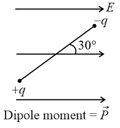EASY
CUET (UG)
IMPORTANT
Earn 100
The torque acting on the dipole and the potential energy are, respectively


(a) in an anticlockwise direction and Joule.
(b) in an anticlockwise direction and Joule.
(c) in an anticlockwise direction and Joule.
(d)none
25% studentsanswered this correctly

Important Questions on Electric Charges and Fields
EASY
CUET (UG)
IMPORTANT
EASY
CUET (UG)
IMPORTANT
EASY
CUET (UG)
IMPORTANT
EASY
CUET (UG)
IMPORTANT
An electric dipole consists of two opposite charges, each of magnitude separated by a distance of . The dipole is placed in an external electric field of . The maximum torque on the dipole is
EASY
CUET (UG)
IMPORTANT
MEDIUM
CUET (UG)
IMPORTANT
EASY
CUET (UG)
IMPORTANT
MEDIUM
CUET (UG)
IMPORTANT
